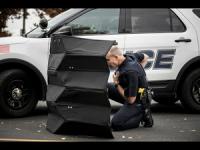-
Purifying wastewater with sunlight
Chemists have found a way to use sunlight to purify wastewater rapidly and cheaply, and to make self-cleaning materials for buildings. The technology uses modified titanium dioxide as a photocatalyst that works with sunlight, unlike other leading water purification products on the market that need ultraviolet light.
-
-
Up to $600 billion in American intellectual property stolen annually

The theft of American intellectual property (IP) remains a systemic threat to the U.S. economy, inflicting an estimated cost that exceeds $225 billion in counterfeit goods, pirated software, and theft of trade secrets and could be as high as $600 billion annually. China remains the world’s principal IP infringer, driven by an industrial policy that continues to prioritize both acquisition and development of science and technology.
-
-
Lasers to keep poultry safe from avian bird flu
Last week, the British government has extended the avian influenza (bird flu) prevention zone to April 2017. Also, the requirements of the zone have changed, meaning keepers may let their birds out provided that they have enhanced biosecurity measures in place. One such biosecurity measure is an automated laser which repels unwanted – and potentially infected — birds without causing harm to the wild birds, the chickens being protected, and the surrounding environment.
-
-
Device rapidly, accurately, inexpensively detects Zika virus at airports, other sites
About the size of a tablet, a portable device that could be used in a host of environments like a busy airport or even a remote location in South America, may hold the key to detecting the dreaded Zika virus accurately, rapidly and inexpensively using just a saliva sample. While scientists across the world are scrambling to find some sort of immunization, researchers are working to develop a diagnostic tool to reduce the impact of the outbreak until a vaccine is identified.
-
-
Bulletproof origami shield to protect law enforcement

Engineering professors have created an origami-inspired, lightweight bulletproof shield that can protect law enforcement from gunfire. The new barrier can be folded compactly when not in use, making it easier to transport and deploy. When expanded — which takes only five seconds — it can provide cover for officers and stop bullets from several types of handguns. The ballistic barrier is made of twelve layers of Kevlar.
-
-
First Israeli nanosatellite launched
“BGUSAT,” the first nanosatellite for Israeli academic research, was launched Wednesday, 15 February as part of a collaboration between Ben-Gurion University of the Negev (BGU), Israel Aerospace Industries (IAI), and the Israel Ministry of Science, Technology and Space. It will provide researchers with data on climate change, agricultural developments, and other scientific phenomena. The nanosatellite is slightly larger than a milk carton (4x4x12 inches) and weighs only eleven pounds.
-
-
SideArm prototype catches full-size drones flying at full speed
Few scenes capture the U.S. Navy’s prowess as effectively as the rapid-fire takeoff and recovery of combat jets from the deck of an aircraft carrier. The ability to carry air power anywhere in the world, and both launch those aircraft to flight speed and bring them to a stop over extremely short distances, has been essential to carriers’ decades-long dominance of naval warfare. To help provide similar capabilities—minus the 90,000-ton carriers—to U.S. military units around the world, DARPA’s SideArm research effort seeks to create a self-contained, portable apparatus able to horizontally launch and retrieve unmanned aerial systems (UASs) of up to 900 pounds. The self-contained, portable apparatus can be used to launch and retrieve unmanned aircraft from trucks, ships, and fixed bases.
-
-
Sandia adds augmented reality to training toolbox
When you hear the term “serious gaming” you might envision professional eSports competitors gearing up for a League of Legends World Championship in front of tens of thousands of live fans and tens of millions of streaming fans. At Sandia National Laboratories, serious gaming means something else entirely. Experts on physical security at Sandia apply the technology and methods of the game industry to real-world national security problems.
-
-
Federally developed technologies go to work
A tool to assess and address cyber and physical security issues and an inexpensive way to create a microscope out of a cell phone are being used by businesses and individuals, thanks to teams who worked to move them out of the laboratory and into the marketplace.
-
-
Low-cost imaging system detects natural gas leaks in real time
Researchers have developed an infrared imaging system that could one day offer low-cost, real-time detection of methane gas leaks in pipelines and at oil and gas facilities. Leaks of methane, the primary component of natural gas, can be costly and dangerous while also contributing to climate change as a greenhouse gas. Infrared device enables reliable monitoring under a range of environmental conditions.
-
-
Dual-use sciene, technological innovation
Scientific research can change our lives for the better, but it also presents risks – either through deliberate misuse or accident. Think about studying deadly pathogens; that’s how we can learn how to successfully ward them off, but it can be a safety issue too, as when CDC workers were exposed to anthrax in 2014 after an incomplete laboratory procedure left spores of the bacterium alive. Making decisions about the security implications of science and technology can be complicated. That’s why scientists and policymakers need clarity on the dual-use distinction to help consider our options.
-
-
Fish scales inspire protective wear
For several years, researchers have been trying to replicate the kind of protection combined with flexibility offered by certain kinds of animal scales. Their goal is to create protective gloves that are both resistant to piercing and still flexible enough. After five years of work, they believe they have done it. The solution came when they started looking more closely at the scales of an alligator gar.
-
-
Do Americans want to buy ‘smart’ guns?
“Smart gun” refers to firearms that include some sort of safety device designed to make sure that the gun can be fired only by an authorized user. These safety devices include fingerprint recognition, wearable “tags” that a gun can recognize and other similar features. Smart guns are not yet widely available on the market. But would Americans actually buy smart guns? We need more studies with larger, nationally representative samples and more detailed questions about smart guns. However, my study sheds light on how subgroups of Americans feel about the issue. Not all gun owners or nonowners feel the same way about smart guns. Support is not evenly divided by political party. American attitudes toward smart guns are complex and do not necessarily follow the patterns we might expect.
-
-
Mobile handheld devices to share battlefield information at multiple classification levels
Troops in remote regions around the world often struggle to operate with limited networks for data sharing and communication—an encumbrance that is amplified when U.S. troops need to share classified or otherwise secure data with each other and coalition partners. DARPA’s Secure Handhelds on Assured Resilient networks at the tactical Edge (SHARE) program aims to create a system where information at multiple levels of security classification could be processed on a single handheld device
-
-
Personal technology aids in criminal proceedings, but poses privacy, rights risks
Personal technology such as fitness trackers and smartphones that record users’ daily activities are likely to be used increasingly in criminal investigations, raising questions about individuals’ rights that the legal system is not yet fully prepared to address. Information such as location, travel patterns, and even physiological details such as heart rate and activity levels could be retrieved from devices as a part of criminal investigations. Such technology offers new tools to law enforcement, but raises unique issues regarding important constitutional rights such as self-incrimination, according to the report.
-
More headlines
The long view
New Technology is Keeping the Skies Safe
DHS S&T Baggage, Cargo, and People Screening (BCP) Program develops state-of-the-art screening solutions to help secure airspace, communities, and borders
Factories First: Winning the Drone War Before It Starts
Wars are won by factories before they are won on the battlefield,Martin C. Feldmann writes, noting that the United States lacks the manufacturing depth for the coming drone age. Rectifying this situation “will take far more than procurement tweaks,” Feldmann writes. “It demands a national-level, wartime-scale industrial mobilization.”
How Artificial General Intelligence Could Affect the Rise and Fall of Nations
Visions for potential AGI futures: A new report from RAND aims to stimulate thinking among policymakers about possible impacts of the development of artificial general intelligence (AGI) on geopolitics and the world order.
Keeping the Lights on with Nuclear Waste: Radiochemistry Transforms Nuclear Waste into Strategic Materials
How UNLV radiochemistry is pioneering the future of energy in the Southwest by salvaging strategic materials from nuclear dumps –and making it safe.
Model Predicts Long-Term Effects of Nuclear Waste on Underground Disposal Systems
The simulations matched results from an underground lab experiment in Switzerland, suggesting modeling could be used to validate the safety of nuclear disposal sites.
